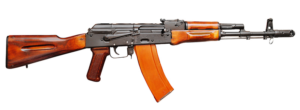
AK-74: The Mainstay Assault Rifle of Both Sides in the Russia-Ukraine War

The Russian “military operation” into Ukraine has seen Russian weaponry dating back to the Cold War era hurling its wrath against a dazzling variety of sophisticated weapons “donated” to Ukraine from an equally wide variety of North Atlantic Treaty Organization powers.
Underlaying the heavyweight weapons that seem to represent Ukrainian quality against Russian quantity are a number of weapons common to both sides. Among the most ubiquitous of these is the lightweight descendent of one of the most iconic and still-ubiquitous infantry weapons in history: the AK-74 assault rifle.
World War II Roots
During World War II, the “infantryman’s friend” was the rifle, whether bolt-action like the Short Magazine, Lee-Enfield; Mosin-Nagant M1891; and Mauser Model 1898, or semi- automatic like the innovative M1 Garand or the M1 carbine.
About midway through the conflict, the Germans began producing a radical weapon designed by Hugo Schmeisser, the Sturmgewehr 44. Introducing an intermediate bullet between the standard rifle round and the short rounds used by “machine pistols” such as Germany’s MP 43 or the Soviet PPSh-41, the StG 44 combined deadly accuracy at hundreds of meters with flexibility of fire, adjustable from single shot to fully automatic. Entering combat too late to change the course of the war, the StG 44, like many other Nazi German developments, had a profound effect on any Allied soldiers who encountered it and inspired a worldwide effort to produce a new generation of infantry weapon during the Cold War.
GET HISTORY 'S GREATEST TALES—RIGHT IN YOUR INBOX
Subscribe to our Historynet Now! newsletter for the best of the past, delivered every Wednesday.
Close
Thank you for subscribing!
Submit
Ak-47 vs. M16
Arguably the most successful of the StG 44’s descendants was designed by Mikhail Kalashnikov in 1947. Firing a 7.62×39 mm round, its principal advance was more like a step backward.
As with many German weapons, the StG 44 was over-engineered and consequently unreliable in the face of the gritty realities of infantry warfare. In significant contrast, Kalashnikov’s version was simpler, easier to produce and, most famously, easy to maintain and operate under extraordinarily down- and-dirty conditions. Over the rest of the 20th century, the AK-47 became not only the principal weapon of the Soviet army but of Soviet allies, Third World customers and, through various means, several of the Soviet Union’s enemies, as well. Although not the finest infantry weapon in the world, the AK-47 is still in wide use, including in Russia and Ukraine in 2022.
The war in Vietnam saw the spread of AK-47 use among the Viet Cong and North Vietnamese, matched by the American M14 semiautomatic rifle and, from 1964 on, the proliferation of a lighter infantry weapon, the M16.
Classic Infantry Rifles
Designed by Eugene Stoner and L. James Sullivan from a basic design dating back to 1959, the M16 fired a 5.56×45 round fully automatic from a 20-round magazine. Initially notorious for its unreliability, the weapon was progressively improved based on troops’ experience, starting in 1969 with the M16A1 with a bolt assist, chrome-plated bore and a 30-round magazine. In 1983, the U.S. Marines — followed by the U.S. Army in 1986 — adopted the M16A2 with a selector for firing semiautomatic single shots, three-round bursts or fully automatic. In 1997, the M16A4 introduced a Picatinny rail for mounting optic and other ancillary devices. Having transitioned from a tragicomic dud to one of the most widespread infantry weapons in the world, the M16 has largely been replaced in recent years by the M4 semiautomatic carbine, essentially a shorter, handier M16. Thus far, production of the various M16 models has exceeded 8 million.
Paralleling the rise of the M16 was that of its ammunition. Lighter and smaller than the 7.62 mm, the 5.56 mm allowed more rounds to be carried and still create the damage and mayhem required of its battlefield mission.
Rise of the Ak-74
This trend extended to Mikhail Kalashnikov, who in 1974 devised an AK-47 to fire a 5.45×39 mm cartridge. In 1979, the __ Avtomat Kalashnikova Obraztsa 1974 goda was adopted by the Soviet army and, as with the M16 in Vietnam, the AK-74 made its combat debut in Afghanistan. Later, the Pakistani bureau of intelligence services, or ISI, claimed that the Central Intelligence Agency paid the Afghan mujahedeen $5,000 for the first AK-74 they captured.
Essentially an AK-47 rebored into a counterpart for the M16, the AK-74 became the standard Soviet infantry weapon, also being license-produced by Bulgaria and East Germany. A total of 5 million have been produced to date. Among its many users was the Ukrainian army after the country attained independence.
AK-74 Stats
As with the M16, later AK-74 variants, the Russian-built AK-74M and AK-12, have Picatinny rails, which allow the use of thermal imaging sights and other aids. Ukrainian hoped to transition to Western rifle designs, but that's been delayed by the difference in bore between the AK-74’s 5.45 mm round, which Ukraine has in abundance, and the relatively few NATO-standard 5.56 mm rounds.
With a maximum range of 3,150 meters and reliability equal to or better than that of the AK-47, the AK-74 will probably remain the principal long arm for both warring sides in the Russia-Ukraine War … as long as the conflict continues.
historynet magazines
Our 9 best-selling history titles feature in-depth storytelling and iconic imagery to engage and inform on the people, the wars, and the events that shaped America and the world.
